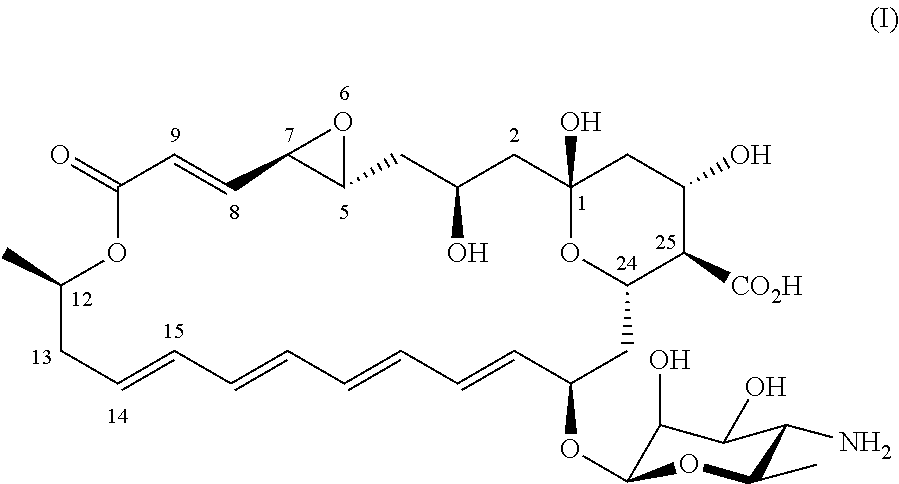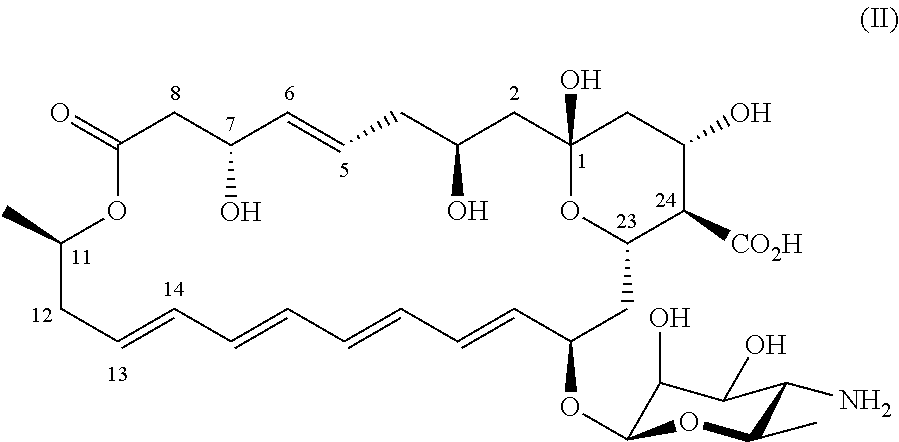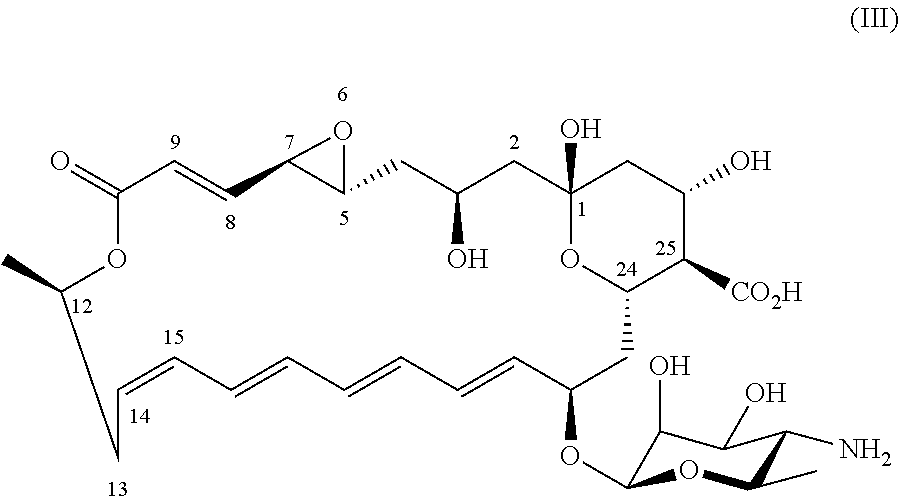Novel all-trans polyene amphoteric macrolide
- Summary
- Abstract
- Description
- Claims
- Application Information
AI Technical Summary
Benefits of technology
Problems solved by technology
Method used
Image
Examples
example 1
[0059]Preparation of (1R,3S,5E,7R,11R,13E,15E,17E,19E,21R,23S,24R,25S)-21-[(3-amino-3,6-dideoxy-β-D-mannopyranosyl)oxy]-1,3,7,25-tetrahydroxy-11-methyl-9-oxo-10,27-dioxabicyclo[21.3.1]heptacosa-5,13,15,17,19-pentaene-24-carboxylic acid (II)
[0060]Natamycin was produced by a culture of Streptomyces natalensis bacteria following a controlled fermentation process, for example as described in WO 97 / 29207 or references therein. A sample of the resulting broth was mixed with an aqueous potassium sorbate solution (3M) and the mixture was stirred until all natamycin was dissolved. The amount of aqueous potassium sorbate solution was such that the resulting concentration of natamycin was 10 g / L (w / w, 1%). In alternative, otherwise similar, experiments dissolution of natamycin was facilitated by raising the temperature to 40±10° C. for 30±20 min followed by cooling down to 20±2° C. The resulting solution was subjected to semi-preparative High-Performance Liquid Chromatography as described unde...
example 2
[0062]Structure elucidation of (1R,3S,5E,7R,11R,13E,15E,17E,19E,21R,23S,24R,25S)-21-[(3-amino-3,6-dideoxy-β-D-mannopyranosyl)oxy]-1,3,7,25-tetrahydroxy-11-methyl-9-oxo-10,27-dioxabicyclo[21.3.1]heptacosa-5,13,15,17,19-pentaene-24-carboxylic acid (II)
[0063]All material from the fraction comprising compound (II) obtained in Example 1 was dissolved in CD3OD (0.6 mL). The sample presumably contained a large amount of glycerol, introduced as a contaminant during freeze-drying. Also signals of free fatty acids were dominant. NMR spectra were recorded on a Bruker Ascend 700 spectrometer operating at a proton frequency of 700 MHz equipped with a TCI cryo probe and measured with a probe temperature of 300K with suppression of the water signal. A 1D 1H spectrum was obtained with 256 scans in 30 minutes, a COSY spectrum was recorded with 8 scans and 800 increments in F1 in 3 hours, TOCSY spectra were recorded with 8 scans and mixing times of 40 and 100 ms and 800 increments in the F1 dimension...
example 3
[0066]Structure elucidation of (1R,3S,5R,7R,8E,12R,14Z,16E,18E,20E,22R,24 S,25R,26S)-22-[(3-amino-3,6-dideoxy-β-D-mannopyranosyl)oxy]-1,3,26-trihydroxy-12-methyl-10-oxo-6,11,28-trioxatricyclo[22.3.1.05.7]octacosa-8,14,16,18,20-pentaene-25-carboxylic acid (Ill)
[0067]All material from the fraction comprising compound (III) obtained in Example 1 was adsorbed on a Sep-Pak column. The column was rinsed with D20 (1 mL). Next, the column was flushed with nitrogen gas. The column was eluted in the reversed direction with CD3CN (1 mL). Compound (III) did not elute from the column which was subsequently eluted with CDCl3 / CD3OD 1 / 1. The solution was transferred into an NMR tube, and further concentrated by means of a stream of nitrogen gas, until a volume of 0.65 mL was obtained. One drop of D20 was added to improve the linewidth in the NMR spectrum.
[0068]NMR spectra were recorded on a Bruker DRX 600 spectrometer, operating at a 1H frequency of 600 MHz. An inverse probe equipped with gradient ...
PUM
| Property | Measurement | Unit |
|---|---|---|
| Temperature | aaaaa | aaaaa |
| Temperature | aaaaa | aaaaa |
| Weight | aaaaa | aaaaa |
Abstract
Description
Claims
Application Information
 Login to View More
Login to View More - R&D
- Intellectual Property
- Life Sciences
- Materials
- Tech Scout
- Unparalleled Data Quality
- Higher Quality Content
- 60% Fewer Hallucinations
Browse by: Latest US Patents, China's latest patents, Technical Efficacy Thesaurus, Application Domain, Technology Topic, Popular Technical Reports.
© 2025 PatSnap. All rights reserved.Legal|Privacy policy|Modern Slavery Act Transparency Statement|Sitemap|About US| Contact US: help@patsnap.com



